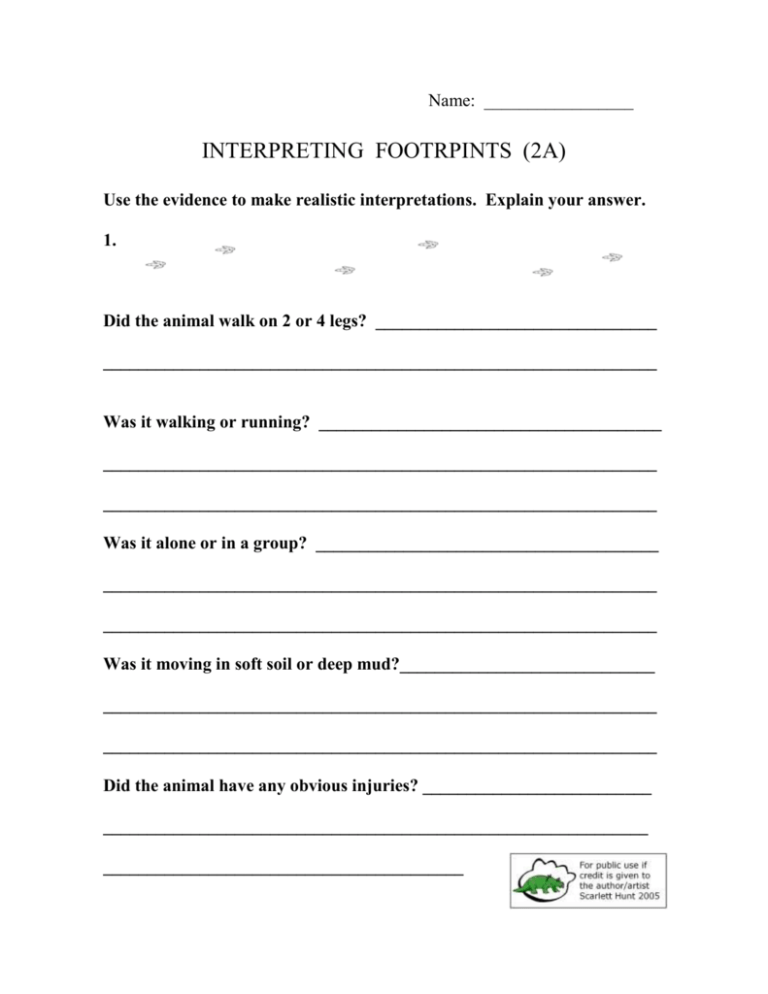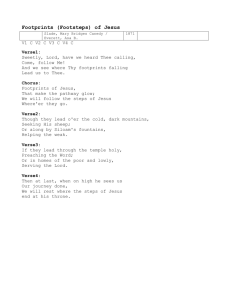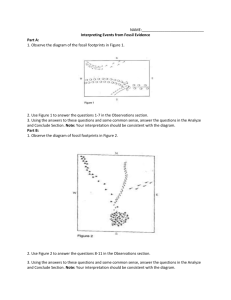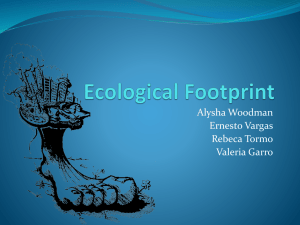Interpreting footprints
advertisement

Name: _________________ INTERPRETING FOOTRPINTS (2A) Use the evidence to make realistic interpretations. Explain your answer. 1. Did the animal walk on 2 or 4 legs? ________________________________ _______________________________________________________________ Was it walking or running? _______________________________________ _______________________________________________________________ _______________________________________________________________ Was it alone or in a group? _______________________________________ _______________________________________________________________ _______________________________________________________________ Was it moving in soft soil or deep mud?_____________________________ _______________________________________________________________ _______________________________________________________________ Did the animal have any obvious injuries? __________________________ ______________________________________________________________ _________________________________________ Name: _________________ INTERPRETING FOOTPRINTS (2B) Use the evidence to make realistic interpretations. Explain your answer. 2. Did the animal walk on 2 or 4 legs? ________________________________ _______________________________________________________________ Was it walking or running? _______________________________________ _______________________________________________________________ _______________________________________________________________ Was it alone or in a group? _______________________________________ _______________________________________________________________ _______________________________________________________________ Was it moving in soft soil or deep mud?_____________________________ _______________________________________________________________ _______________________________________________________________ Did the animal have any obvious injuries? __________________________ _______________________________________________________________ ____________________________________________ Name: _________________ TRACKWAYS 1 The shape and pairing of a footprint is different for animals who walked on two feet (bipeds) and animals who walked on four feet (quadrupeds): Biped prints are usually left to right sequences of similarly shaped prints. They each have three major digit (toe) marks and small and shallow hallux marks (triadactyl tracks). Quadruped prints generally show rear and front prints of different sizes and shapes. The rear prints are larger than the fore prints. The front foot of a quadruped animal is called the manus, whereas the back foot is called the pes. The tracks above indicate that the animal walked on two feet (or in other words was "bipedal"). Bipedal dinosaur trackways contain similarly sized and shaped prints in pairs. Each print alternates -usually from left to right. They tend to make very narrow trackways which may appear to be in a straight line. These tracks indicate that the animal walked on four feet (or in other words was "quadrupedal"). The front and rear prints of quadrupedal dinosaur tracks usually have different sizes and shapes. The rear prints are larger and broader in shape than the front. Trackways show the front print slightly in front of the back print on each side of the trackway. Name: _________________ TRACKWAYS 2 Some animals like hadrosaurs (and modern kangaroos or bears) change their movement from bipedal to quadrupedal. These are either called facultative bipeds (usually use two feet) or facultative quadrupeds (usually use four feet). Draw the footprints of each animal: For an extra activity, make some icebox cookies or sugar cookies in the shape of dinosaur footprints. Have each student make their own mini trackway across his or her plate before eating the footprints. Name: _________________ CHANGES The study of footprints has brought exciting changes in palaeontology. At first palaeontologists thought that dinosaurs walked like lizards. They built their dinosaur skeletons standing up straight, with their legs spread out, and their tails dragging. When they found dinosaur footprints they had to change their old ideas about dinosaurs. The new evidence proved that they were wrong. They had to redo their models of dinosaurs so that they were leaning forward with their tails in the air. If a dinosaur looked like this its footprints would have: If a dinosaur looked like this its footprints would have: Feet palm first Smaller steps Feet to side of body Marks from tail dragging Feet toe first Longer steps Feet almost underneath body No tail marks on the ground Name:_________________ _________________ FOSSILIZED FOOTPRINTS 1. 2. The dinosaur steps its foot into soft dirt or mud. A footprint is created. Water flows over the footprint. Some dirt in the water starts to fall into the footprint. More dirt in the water falls into the footprint. 3. 4. The footprint is buried in dirt. The water dries up or drains away. A layer of dirt forms on top of the first layer. 5. 6. Pressure squishes the layers and they turn into rock. Millions of years pass. 7. A palaeontologist finds the fossilized footprint. 8. 9. The palaeontologist then separates the layers. The top layer shows the shape of the foot that made the print. The bottom layer shows the original footprint. 10. The palaeontologist then makes a mould of the footprint and pours plaster into it. When the plaster hardens, it is a model of a footprint. Name: _________________ INTERPRETING FOOTPRINTS 1A Footprints can tell us… Whether the animal walked on 2 legs, 4 legs or switched back & forth A bipedal animal walks on two legs only. Both the prints are the same size and shape. You can draw an imaginary line in between the left footprints and the right footprints. A quadrupedal animal walks on four legs only. There are two different sizes and shapes of prints. The front footprints are smaller than the back footprints. A facultative biped usually walks on two legs but can sit on four or sometimes walk on four. A facultative quadruped usually walks on four legs but can walk on two sometimes. How fast the animal moved R. McNeil Alexander figured out how to calculate the speed of a dinosaur by measuring its footprints, length of step and leg length. Velocity=0.25*(stride length)1.67*(leg length)-1.17*(gravitational constant)0.5 How heavy the animal was Palaeontologists look at how deep the footprint is, how clear the footprint is, and what the soil was made of. They also compare dinosaur footprints to animal footprints today. Name: _________________ INTERPRETING FOOTPRINTS 1B Footprints can tell us… Whether the animal traveled alone or in groups Palaeontologists look for sets of footprints that are from the same kind of dinosaur. When they find many footprints of the same kind of dinosaur, they think it was a herd (group) of dinosaurs. If they find only one set of footprints, then they think that the dinosaur was alone. How it sat or stood while resting An animal could stop to rest. It might stand on two legs and drop its two front paws on the ground for balance. Which kinds of animals lived in the same area at the same time Palaeontologists look for sets of footprints that are from different kinds of dinosaurs. They look for footprints stepping on other footprints. What kind of ground the animal walked on Clear footprints mean that the ground is hard and a bit dry. Very wet ground makes footprints that are deep and sunken in. If the animal traveled with youth and babies Palaeontologists look for sets of footprints that are from the same kind of dinosaur but are different sizes. Name: _________________ INTERPRETING FOOTPRINTS 1C Footprints can tell us… If the animals walked in a group or single file Palaeontologists try to figure out if the same kinds of animals were traveling in a straight line (single file), in a herd (large group). Whether the animal limped, had broken toes or other injuries If the dinosaur had a bad leg it would limp and have uneven strides. (The distance between the footprints would be different on one side.) If the dinosaur had a broken tie, the footprint would show it. If the animal changed speed or distance in an action sequence The theropod footprints and sauropod footprints are from the Islet of Fenoliga, Istria. This might show dinosaurs trying to hunt each other. What shape the animal's feet were The dinosaur that made this footprint would have short toes. Its feet would be very round. The dinosaur that made this footprint would have three very long toes.







